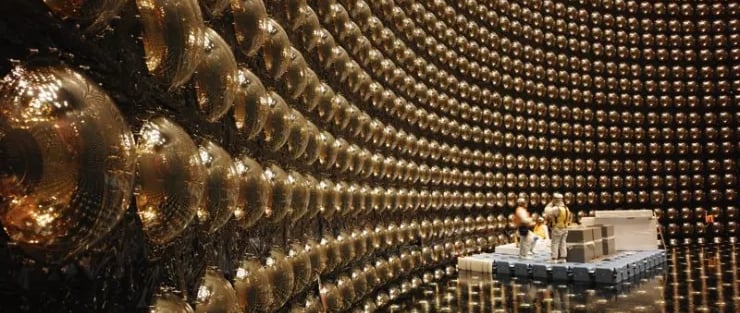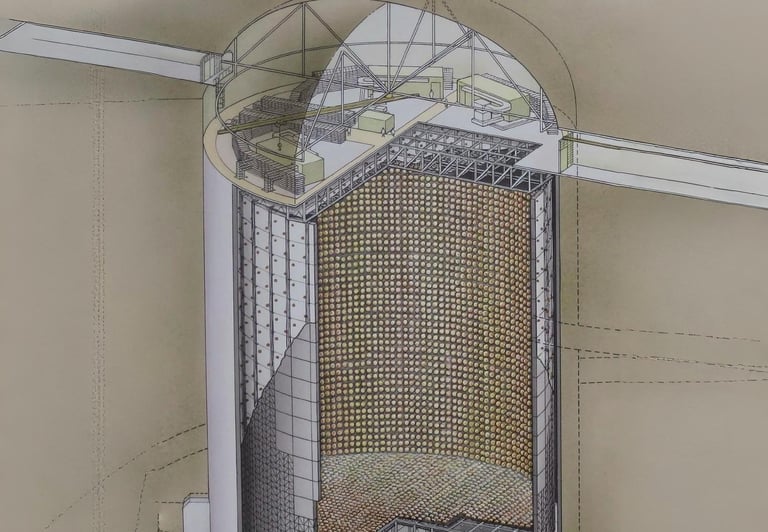Japan’s Golden Chamber: The Purest Water on Earth That Can Dissolve Metal
Hidden beneath Mount Ikeno in Japan lies the Super-Kamiokande, a giant underground neutrino observatory. This stunning golden chamber holds over 50,000 tons of ultrapure water—so pure that it can slowly dissolve metal. The water is used to detect neutrinos, ghost-like particles that pass through matter undetected. The chamber is lined with thousands of sensors that capture tiny flashes of light caused when neutrinos interact with water. Its golden glow and extreme conditions make it both visually breathtaking and scientifically groundbreaking. The observatory has contributed major discoveries, including proving that neutrinos have mass, and helps scientists study supernovae and the secrets of the universe.
IMPOSSIBLE
Thrivevision
4/6/20252 min read


Inside Japan’s Golden Cave: The Super-Kamiokande Neutrino Observatory
Deep beneath Mount Ikeno in Japan, hidden from the everyday world, lies one of the most extraordinary scientific instruments on Earth. It’s not a laboratory filled with buzzing computers or towering machinery. Instead, it’s a vast, glowing chamber filled with water—so pure it can dissolve metal—and lined with golden lights. This is the Super-Kamiokande, a place where scientists hunt the universe’s most elusive visitors: neutrinos.
A Chamber of Light and Mystery
The Super-Kamiokande, or “Super-K” as it’s often called, looks like something straight out of science fiction. The massive cylindrical tank is filled with 50,000 tons of ultrapure water, and its inner walls are lined with more than 11,000 light sensors known as photomultiplier tubes (PMTs). These sensors aren’t just decoration—they’re crucial to the observatory’s mission.
Despite their ghost-like nature, neutrinos occasionally interact with the water, creating tiny bursts of light known as Cherenkov radiation. These bursts are incredibly faint and fleeting, but in the pitch-black stillness of the chamber, they can be captured by the PMTs—like stars blinking in an artificial underground sky.
Why Neutrinos Matter
Neutrinos are subatomic particles produced by nuclear reactions in the sun, in stars, and during cosmic events like supernovae. They pass through matter—planets, people, and even mountains—almost entirely undisturbed. That’s what makes them so hard to detect, and why the Super-Kamiokande had to be built 1,000 meters underground, shielded from cosmic rays and noise.
But why chase something so elusive? Because neutrinos hold clues to the fundamental laws of physics. One of Super-K’s greatest achievements was helping to prove that neutrinos have mass, a discovery that challenged long-standing assumptions and earned part of the 2015 Nobel Prize in Physics.
A Temple of Science and Beauty
The Super-Kamiokande isn’t just a marvel of engineering—it’s visually stunning. The gold-like glow of the sensors, the mirror-like water, and the serene, silent atmosphere give it an almost spiritual feel. It’s often compared to an underwater cathedral, where instead of worship, scientists seek answers to cosmic mysteries.
The observatory continues to play a key role in studying supernovae, dark matter, and the origins of the universe. It’s part of a global effort to unravel questions that have puzzled humanity for centuries—right from a hidden mountain chamber in Japan.
Final Thoughts
The Super-Kamiokande reminds us that the pursuit of knowledge can be as beautiful as it is profound. In the quiet stillness beneath Mount Ikeno, scientists are watching for whispers from the stars, flashes of light that last a moment but reveal secrets millions of years old. It's a place where the boundaries between art, science, and wonder blur—and where the universe speaks, one neutrino at a time.


Inspiration
Explore success stories and motivational journeys today.
Growth
Vision
© 2025. All rights reserved.
